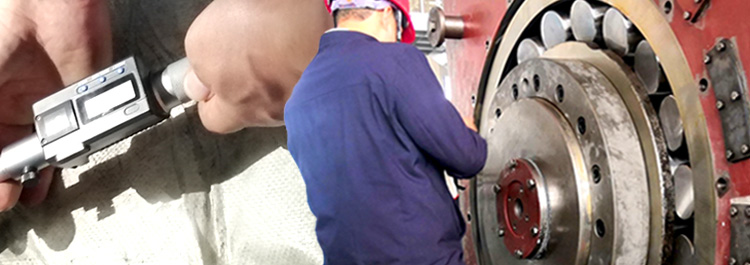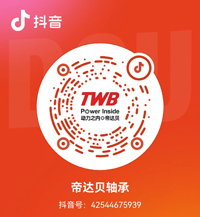1. Regular Inspection
Regular maintenance (regular inspection) must be done to achieve the bearing life and performance. Periodic inspection helps to detect early damage and prevent accidents before they occur. It is of vital importance to raise productivity and economic efficiency.
The main methods are as follows
1.1Bearing damage Diagnosis Methods:
Identifying or predicting whether the operating bearing is damaged or not without dismounting for inspection is very important to raise productivity and economic efficiency. Main identification methods include:
a. Identify through Sound
Rich experience is the prerequisite for conducting sound identification. Only sufficiently trained operators can identify the sound of a bearing. Therefore, it needs a specialized operator for this job. The listening gear or listening rod presses against the housing may help to listen to the sound of the bearing.
b. Identify through Operating Temperature
This method is called identification through comparison, and is only applicable in the steady state application. Therefore, the temperature must be continuously recorded. Any bearing damage will make temperature rise abnormally.
c. Identify through lubricant condition
Judge through lubricant contamination(foreign particles or metal powder etc.) by sampling and analyzing lubricant. This method is especially effective for the bearings inaccessible or of large size.
1.2Bearing Inspection
Inspect the dismounted bearings during equipment regular maintenance, operation check and the circumjacent components replacement to judge the bearing service condition and whether bearing can be reused or not. After sampling, the bearing should be well cleaned. Inspect the raceways, rolling surfaces, the fitting surfaces and the wear condition of the cages to determine if they have been damaged or in abnormal condition.
Cautions to bearing cleaning: Need to take photos and well record the bearing visual condition during inspecting dismounted bearings. In addition, need to confirm the volume of surplus lubricant and to sample lubricant before bearing is cleaned.
Used detergent is neutral water- free diesel or kerosene. Sometimes, temperate lye is used as needed. When use a detergent always use filter. Oil or grease the bearing immediately after cleaned.
1.3 Whether the bearing can be used again is determined by the bearing condition, machine performance and importance, the operating condition and the inspection cycle etc. If the bearing is found damaged or in abnormal condition, it is necessary to find out the causes and fix up with some countermeasures. If there is any of the following damages, the bearing can not be used any more. Instead, it should be replaced with new one.
a. Cracks or fractures appeared in inner ring, outer ring, rolling element or cage.
b. Spalling occurred in inner ring, outer ring or rolling element.
c. Raceway, flange or rolling element has obvious squeeze scars.
d. Severe wear or rivet loosening of the retainer.
e. Raceway and rolling element rusts or scars.
f. Raceway and rolling elements have obvious denting and stricken marks.
g. The bore of the inner ring or the OD of the outer ring have creep deformation.
h. Severe discoloration caused by overheating.
i. Severe breakage on the seal or shield of the sealed bearing.
2. Inspection and damage analysis in Operation
Check on bearings’ sound, vibration, temperature and lubrication condition during inspection. Use these factors in your analysis when introducing lubrication.
2.1 Function of Bearing Lubrication:
Lubrication plays an important part in the bearing fatigue life span, without the appropriate lubrication the bearing could experience friction, wear, temperature rise, and vibration and will not work. Analysis of the cause for the bearing damage indicates that about 40% of bearing damage is related to poor lubrication. Therefore, good lubrication is an effective measure to reduce bearing friction and wear. Apart from this, bearing lubrication also functions to dissipate heat, protect against corrosion, seal the bearing against contaminants and mitigate shock etc. as the following:
a. A layer of oil film is formed between two rolling or gliding surfaces. The oil film layer separates the two surfaces and reduces friction and wear at the interface.
b. Oil lubrication, including circulating oil, oil mist and splash oil systems can take away most friction heat within the bearing.
c. While using grease lubrication, foreign particles like dust may enter the bearing, working as a seal.
d. All lubricants help to prevent corrosion.
e. Improve the bearing fatigue life.
2.2 Grease Lubrication
Greases consist of base oil, a thickening agent and additives. Bearing application conditions should be considered when choosing grease. Grease performances may vary for different brands. Normal greases for bearings include calcium soap grease, sodium soap grease, calcium-sodium soap grease, lithium base grease, aluminum base grease, .molybdenum disulfide grease, etc.
2.3 Grease selection
Grease should be selected with considering its dropping point, oxidation stability and cryogenic property at operating temperature. Dropping point is often used to assess grease high-temperature property and the actual operating temperature of the bearing should be 10-20℃ lower than the dropping point. Operating temperature of synthetic grease should be 20-30℃lower than the dropping point. Bearing load should be considered when selecting the grease. For heavy load applications, you should choose low penetration grease. For high pressure applications, in addition to the low penetration property the grease should also have thicker oil film and extreme pressure property. Calcium -based greases have excellent water resistance and are used in industrial applications where water ingress is an issue.
2.4 The grease filling amount in the bearing:
It is filled about ½ ~ 1/3 in the volume of internal open space of the bearing. The amount of grease should be reduced to 1/3 of the open space for the high speed application. Excessive grease will cause high temperature.
2.5 Replenish and Replacement:
Due to mechanical action, aging and contamination, bearing lubricants will gradually lose their properties. Therefore, lubricants must be continuously replenished and renewed. The interval of lubricant replenishment will differ with the type, size and the speed of the bearing. Therefore, the interval is according to the operating speed. Additionally, the replenishment interval should be reduced by half for every 15° C increase in temperature when bearing operating temperature is over 70° C. Two sides sealed bearings have been filled with grease during manufacturing. Generally, grease operational life is longer than the bearing life.. Except for special occasions, there is no need to replenish lubricating grease for the two sides sealed bearings.













